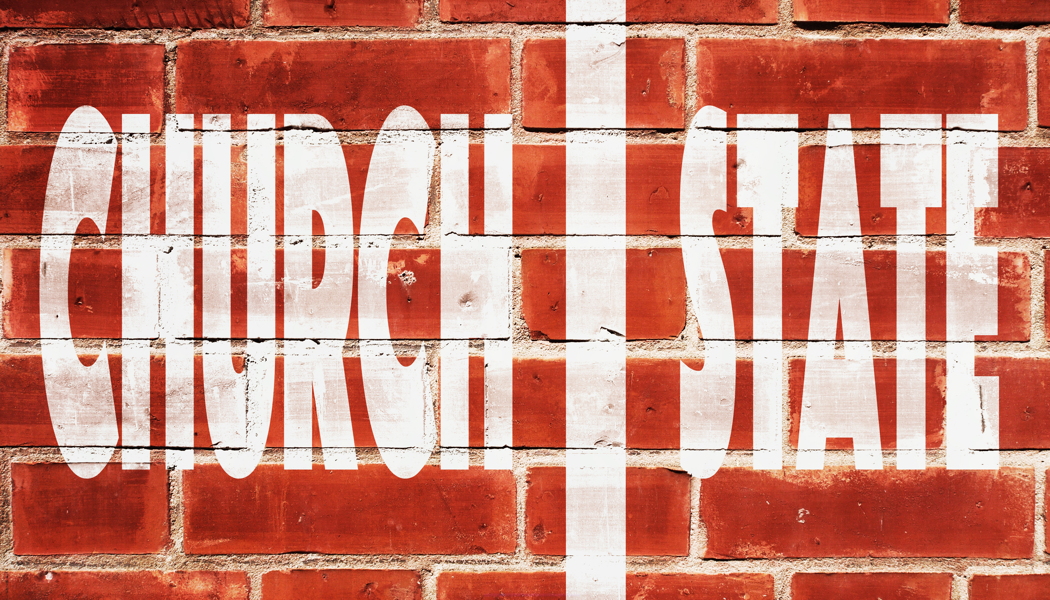
The logical fallacy behind the wall of separation between church and state has been hidden in plain sight for over two centuries. A little logic reveals the misconception and explains its power to legalize prejudice. Because the wall is founded on an inadvertent delusion, we should expect to find symptoms of that error on both sides of the wall. And so we do.
The False Dichotomy on the Church Side of the Wall
Proposition: In a legislative context, “religious/nonreligious” is a false dichotomy.
This is the crux of the fallacy. In common parlance, we use the word “nonbeliever” to denote “one who does not believe in deity”. But if we go a level deeper, we see a false dichotomy. We expose this by restating the above as “one who believes not in deity”. These are equivalent statements, but the second one reveals that the nonbeliever indulges, as we all do, in that activity we call “believing”. He believes alright, just not in a supreme being. In fact we are all believers in this broader sense.
 The false dichotomy is also revealed by the concepts of a “worldview” and a “belief window”: two different labels for essentially the same thing. Here the important facts are that we all have them, and that they function exactly the same way as a religion. But just to be certain, let’s look a bit closer.
The false dichotomy is also revealed by the concepts of a “worldview” and a “belief window”: two different labels for essentially the same thing. Here the important facts are that we all have them, and that they function exactly the same way as a religion. But just to be certain, let’s look a bit closer.
To discover one’s worldview, religion, etc. it is only necessary to start with any principle or conviction and ask, “And why do you believe that.” Regardless of the answer, restate the question. This takes one deeper and deeper. At the bottom, the answer becomes a confession of faith such as “Because I think …” or “Because I believe …”.
Worldviews, Belief Windows, Religions
For a religious person, his religion is his worldview/belief window. This worldview constantly guides and informs his decisions and actions. The nonreligious person has a worldview which is quite different on the surface (he doesn’t believe in a deity, for example), but his worldview nevertheless, has an equally decisive effect upon his actions and choices. Thus, although we say he is nonreligious, he is necessarily subject to his worldview just like a religious person.
So the point is: in spite of the confusion our words inflict on us, we are all believers in what we believe. We all choose our actions based on our world view, belief window, religion, philosophy of life, value system, or whatever you may choose as your favorite label for this universal fact of our subjective existence. This is true whether or not you believe in a deity.
Finding: We are all religious, in the broad sense of the word. Hence, “religious/nonreligious” is a false dichotomy for no matter what we believe, we are inherently equal under the law.
The Failed Secularism on the State Side of the Wall
Proposition: All laws affecting citizen rights are based on religious values.
This statement flies in the face of secularism, that well-established goal of western legislation. But we shall see that the religious/nonreligious dichotomy discussed above has also hidden the impossibility of drafting secular laws that affect citizen behavior. Here’s why.
 A law is the result of someone’s desire for a “public good”. We find near universal harmony among legislators on this point. That unity falls by the wayside when the discussion turns to specific “goods”. The source of their disagreements is the value systems (religions) of the individual legislators. This seems patently obvious, but this source is only rarely identified correctly as being religious.
A law is the result of someone’s desire for a “public good”. We find near universal harmony among legislators on this point. That unity falls by the wayside when the discussion turns to specific “goods”. The source of their disagreements is the value systems (religions) of the individual legislators. This seems patently obvious, but this source is only rarely identified correctly as being religious.
One congressman thinks that unisex public restrooms are a great way to save money while another thinks such restrooms would further degrade the family. And they hold the family as a fundamental “good”. Choose any hot topic in congress and you can trace the disagreements to the worldviews/religions of the legislators. You could begin with abortion, or gender rights, or immigration, or …
It is clear that any legislation affecting the behavior of citizens will inherently foist some religious principle upon the citizenry — using “religious” in the broad sense discussed, of course.
Finding: It is inherently impossible to write a secular law affecting the rights of citizens: thus the principle of a wall of separation has no traction for it is impossible to separate something from itself.
Conclusions:
1. It should not surprise us that the fatally flawed and simplistic legal concept of a wall separating church and state would generate problems. One cannot read court opinions without being impressed with the meticulous, even pained arguments put forth in their rulings. Recent statements by Justices of the US Supreme Court are indicative of the struggle they have wrestling with the issues the wall brings to the surface. But the wall is a semantic figment and the issues it seems to reveal are apparitions born of a fallacy.
2. With the dissolution of the wall, we can move toward greater freedom: the free exercise guaranteed by the first amendment.
3. The false separation paradigm has facilitated the establishment of atheism as the official state religion by slowly restricting free exercise. It has done this by putting the believer at a disadvantage because the non-believer’s agenda always seemed secular.
 4. Separation is a specious, insidious, and bigoted legal theory. It is specious because it is a fallacy with a historic and plausible facade, insidious because it is hidden in plain sight, and bigoted because it puts believers and nonbelievers on uneven ground by making nonbelievers’ religious values appear secular.
4. Separation is a specious, insidious, and bigoted legal theory. It is specious because it is a fallacy with a historic and plausible facade, insidious because it is hidden in plain sight, and bigoted because it puts believers and nonbelievers on uneven ground by making nonbelievers’ religious values appear secular.
5. The dissolution of the federal wall of separation paves the way for SCOTUS to gracefully separate itself from these issues. That would restore the sole jurisdiction the states were promised in the tenth amendment. This in turn would lead to a celebration of diversity like we see across Europe. Furthermore, it is easy to see that the least contentious path is to settle church and state issues town my town. A federal, one-size-fits-all approach fits no one.
6. Those who have loved the operation of the wall upon legislation and court rulings will be very unhappy about this exposure of the fallacy that became a wall of separation. There will be loud protestations and strange attempts at logical defeat of this discovery that has lurked just beneath the surface to two centuries. There will be predictions of horrible outcomes: of religion taking over everything. But religion has already taken over everything as demonstrated above. It has become the primary source of the great division in our society. Citizens will handle that much better when they learn the source of their discontent.
7. It is not too soon to plan how this truth can make us free.
- Face it! It’s a Storm! - April 22, 2024
- An Open Letter to Tucker, Glenn, Laura, et al. - December 15, 2023
- Pray Like a Mustard Seed - November 26, 2023





Thanks for your thoughts! I’m in the middle of moving house, so am slow to respond. I think I understand what you are saying and if so I agree. In the context of the first amendment which uses the word “religion”, the idea of organized, or not, seems pretty non-relevant. The common phrase “church and state” is where the problem arises, I think. It’s a pretty loose expression that people use a lot but it often muddles the issues a bit.
I love the ideas you have presented here as the pertain to the recognition that we are all “believers.”
I am going to evaluate them further in your larger argument of the fallacy of separation.
I have a concern that the logic of: church = religion = religious = belief system has left behind an essential element of church: organization. This logic would be more correct: church = organized religion = an institution of religious individuals = subscribers of the same belief system who identify with and sustain a larger entity.
I’m not sure that “organized church(es)” can be swapped out for “individual(s) with belief systems” when arguing around the church and state clause.